Photo

Liner notes to the “French Dispatch” soundtrack (ABKCO, 2021):
I went to a party in Paris twenty years ago at an old nightclub called Castel.
I was seated next to a small, long-haired, slightly birdlike man with a white beard. He wore blue-tinted sunglasses. He didn’t speak much English, and I didn’t speak much French. Nevertheless, we shared a warmly abstract, blurry conversation throughout the dinner. Just before dessert, someone appeared over his shoulder and whispered in his ear. My companion nodded and wandered over to a little Yamaha keyboard on a stand in the corner and turned it on. He started playing a tune and singing in his equally-birdlike voice—and, at the chorus, the entire nightclub exploded in unison singing along with him. At which point, I realized, the small, soft-spoken, birdlike man was a legendary French pop icon.
The song was “Aline,” and Christophe died after we made our movie—but before we could release it. The duet we had hoped he and the magnificent Jarvis Cocker would perform together was not to be. Our character of Tip-top is an homage to him, to Jacques Dutronc, to Françoise Hardy, to Serge Gainsbourg, to a generation of unforgettable French musical stars unlike those of any other nation.
--W.W.A.
#frenchdispatch#alexandredesplat#christophe#aline#jarviscocker#serge gainsbourg#jacques dutronc#francoisehardy
1 note
·
View note
Text

Foreword to "Accidentally Wes Anderson" by Wally Korval (Voracious, 2020):
The photographs in this book were taken by people I have never met, of places and things I have, almost without exception, never seen—but I must say: I intend to.
Wally Korval and his collaborators have put together both a very entertaining collection of images and also an especially alluring travel guide (at least in the opinion of this actual Wes Anderson). There must be about 200 locations here, which should keep me busy for several decades, but I plan not to let any of these experiences escape me, especially the Croatian pancake stand (page 95).
I now understand what it means to be accidentally myself. Thank you. I am still confused what it means to be deliberately me, if that is even what I am, but that is not important. I send my very best wishes and much gratitude to this group for discovering and sharing all these peculiar and fascinating vistas.
—Wes Anderson
0 notes
Photo

Introduction to exhibition catalog: "Spitzmaus Mummy in a Coffin and other Treasures” (Kunsthistorischen Museum, 2018) curated by Wes Anderson and Juman Malouf:
“While Juman Malouf and I can take no credit for the conception and creation of any of the works of art included in this exhibition, we do harbor the humble aspiration that the unconventional groupings and arrangement of the works on display may influence the study of art and antiquity in minor, even trivial, but nevertheless detectable ways for many future generations to come.
“Some of the links are more immediately apparent than others. We situate the seventeenth century emerald vessel in a confined space opposite the bright green costume from a 1978 production of Hedda Gabler in order to call attention to the molecular similarities between hexagonal crystal and Shantung silk; we place the painting of a seven-year-old falconer (Emperor Charles V) next to the portrait of a four-year-old dog owner (Emperor Ferdinand II) in order to emphasize the evolution of natural gesso; a box for the storage of Spanish powdered wigs goes next to a case for the storage of the crown of the king of Italy because both were so clearly shaped and formed by the introduction of the hinge. The list goes on.
“True: one of the Kunsthistorisches Museum’s most senior curators (educated, of course, at the University of Heidelberg) at first failed to detect some of the, we thought, more blatant connections; and, even after we pointed most of them out, still questions their curatorial validity in, arguably, all instances. But, should our experiment fail on these levels, we are, nevertheless, confident it will, at the very least, serve the purpose of ruling out certain hypotheses, thereby advancing the methods of art history through the scientific process of trial-and-error. (In this case, error.)
“Our hope, however, is we will shed some light into corners that had previously been too dim for comfortable viewing.“
#wes anderson#wesanderson#juman malouf#jumanmalouf#spitzmaus mummy in a coffin#spitzmausmummyinacoffin#kunsthistorischen museum#kunsthistorischenmuseum
0 notes
Photo

“Hörnblowér: Profile of a Shepherd,” chapter in “Beastie Boys Book” (Spiegel & Grau, 2018) by Michael Diamond and Adam Horovitz:


7 notes
·
View notes
Text
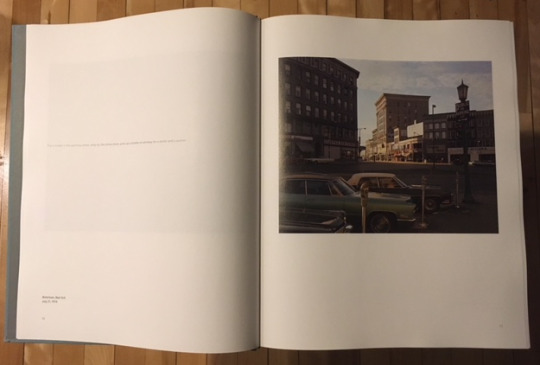
Photography captions in “Stephen Shore: Selected Works 1973-1981″ (Aperture, 2017):
(About the book: “In the following pages, an international group of artists, curators, authors, and cultural figures have selected up to ten photographs apiece from Stephen Shore’s Uncommon Places archives. None of the images appear in the current edition of his landmark book of the same name; most are published here for the first time. Each suite of photographs, chosen from over four hundred newly scanned or rediscovered negatives, offers an idiosyncratic commentary on Shore’s distinctive vision of America and proposes new perspectives on this seminal body of work from the 1970s and early ‘80s.”)

A successfully completed jig-saw puzzle looks its very best nailed to this dry-wall siding. (Caption for Cabin #8, Beach Motel, Ashland, Wisconsin July 9, 1973)

Put a nickel in the parking meter, stop by the dime-store, pick up a bottle of whiskey for a dollar and a quarter. (Watertown, New York July 31, 1974)

A weekend morning at this silent dentist’s office or possibly an accountant. Is there a small atrium in the building? With a turtle in it. (Lovers Lane, University Park, Dallas, Texas June 16, 1976)
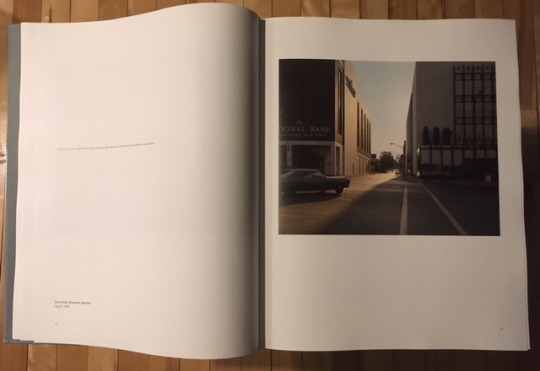
Thirty seconds after time-vault opens: get-away car moves into position and idles. (Stone Street, Watertown, New York July 31, 1974)

Perhaps this image conjures up August Sander’s wandering documentation of the people of his day. This man thinks: what is so interesting about ME? (West Fourth Street, Fort Worth, Texas June 18, 1976)

Waiting for the scrimmage to end. An ice-chest somewhere filled with Nehi grape sodas? (Penfield, New York August 12, 1977)

What electrical appliance requires its power down there below? It is a mystery. (Room 31, Forks Motel, Forks, Washington August 28, 1974)
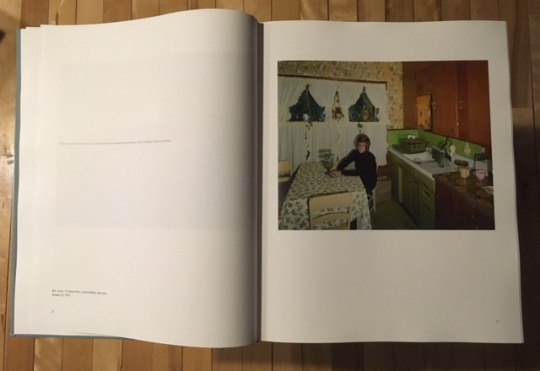
Certain shades of green and orange are best experienced when cast in deeply lustrous plastic. (Mrs. Evans, 17 Teresa Place, South Buffalo, New York October 25, 1977)
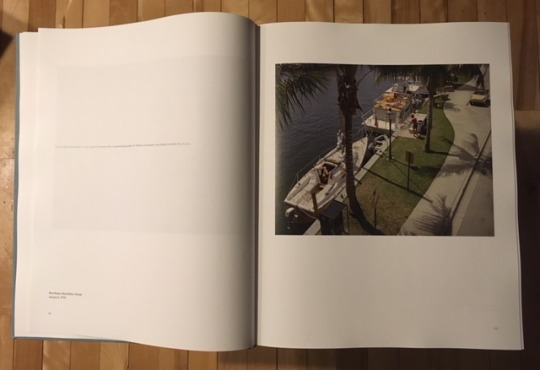
This might have been a very good location for a special episode of Three’s Company recorded outside the studio. (Boca Bayou, Boca Raton, Florida January 4, 1974)

A Bruegel of Yonkers. (Lockwood Avenue, Yonkers, New York November 19, 1973)
0 notes
Photo

Foreword to “The Wes Anderson Collection: Bad Dads: Art Inspired By The Films Of Wes Anderson“ by Spoke Art Gallery (Abrams Books, 2016):
My father was the first person to mention to me, several years ago, that some people in California were putting on an art show with pictures based on characters in my movies—and that it was going to be called Bad Dads.
He did not like the title at all. (He has always been more of a good dad, and it rubs him the wrong way when people confuse him with some of our fictional characters. He monitors with Google Alert.) He did, however, like the pictures. For me, it is extremely encouraging to know that somebody-or-other somewhere is interested enough to make something-or-other new of their own inspired by something-or-other old of my own—that was in itself inspired by all sorts of other something-or-others somebody else invented before that. In fact, I have, on more than one occasion, turned to an artist represented/discovered in this series of exhibitions to make pictures for use in my own ongoing movies. (Rich Pellegrino, in particular, made a sort of a Schiele-esque watercolor for The Grand Budapest Hotel which is known as Two Lesbians Masturbating, and I think we can say he got that one just right.)
Jason Schwartzman and I paid a visit to the last Bad Dads show when it made its appearance in New York. By the time you get yourself out of the cutting room on a movie, you usually have a strong desire no to be exposed to the material ever again for the rest of your life. But, it turns out, after a decade or two, it can be a nice feeling to revisit the old characters. Jason and I moved from picture to picture with our hands in our pockets, nodding and murmuring. I guess we were kind of walking down memory lane. I cannot take credit for much of anything on these pages, and I do not even know if it is actually legal to publish this book? It probably violates if not my own personal copyrights then almost certainly those of a number of multinational entertainment conglomerates. But, for whatever it is worth, I approve, and I hope you will, too.
Wes Anderson
January 2016
New York, NY
#rich pellegrino#jason schwartzman#spoke gallery#wes anderson#wesanderson#richpellegrino#spokegallery#jasonschwartzman
0 notes
Photo

Foreword to “Mark Mothersbaugh: Myopia” (Princeton Architectural Press, 2014)

PROSPECTUS
I hope soon to secure the means to commission the construction of an
important and sizable theme park to be conceived and designed entirely by
Mark Mothersbaugh.
It will include hundreds of animatronic characters and creatures, rides
through vast invented landscapes and buildings, extensive galleries of
textiles and sculptures, plus an ongoing original music score piped-in
everywhere. The only stipulation required for the park’s contents are that
they all be his. You see, Mr. Mothersbaugh works in virtually every form
and medium, and his work has always been unified and singular (perhaps a
result of the simple fact that it all comes from the same exotic and
densely populated alien planet: his brain). For forty years, he has set
about creating a body of work which amounts to his own Magic Kingdom, and
I suggest that the time has come for it to be fully realized on a
humongous plot of suburban real estate beyond the outskirts of Akron,
Ohio.
The visitor will be amused and frightened, often simultaneously. There
will be numerous motifs: medical experimentation, mutated portraiture,
mysterious manifestos, strange little babies. There will be a constant
influx of new images – because he is always drawing. There will be
virtuosic performances, surprising costumes, and always something a bit
inscrutable. In short, like all his work, it will resemble a visit with
the man himself.
In the meantime, I believe the collection of startling and wondrous
creations on these pages and in this exhibition serves to make my case
and, I pray, will win it.
0 notes
Photo

Footnote to Introduction to the “Grand Budapest Hotel” screenplay (Opus Books, 2014), story by Hugo Guinness and Wes Anderson.
INTRODUCTION
by Hugo Guinness
I remember in Paris, 2007, Wes and I spent some time in restaurants and cafés and on walks in public parks discussing a mutual friend of ours. We talked about the things he said, his life, his mannerisms. He was an unusual character – full of anecdotes, charm, and bon mots.
He made us laugh.
Wes would write occasional casual notes about him. I then returned to New York and heard nothing from Wes about this character for five or six years. He was forgotten.
In 2012, out of the blue, Wes revived him.
We worked together over a period of several weeks and then multiple telephone calls. The character became M. Gustave H, the bisexual concierge of a hotel in middle Europe. A plot was devised around him, and dialogue was written, inch by inch. I would offer the occasional comment and answer Wes’s hypothetical questions. If an idea or a line of dialogue by me actually got into the script, it was a good day. Mostly I just listened, and my suggestions were ignored. In a few short weeks, the script was finished, and Wes was off to East Germany to shoot The Grand Budapest Hotel.
FOOTNOTE
by Wes Anderson
Hugo has either deliberately or involuntarily distorted the above account of our collaboration.
I do not recall him ever being satisfied to see his suggestions ignored. He would, instead, become extremely moody and irritated in those instances, which usually makes him slightly funnier, and it’s when he came up with some of our best bits.
Also, he is not inclined to sit back and listen. His instinct, I find, is to disagree and say something slightly belittling. His criticism is always insightful and pointed, not to say cruel, which helps it stick in the mind, often permanently. His contribution to this story should not be underestimated by anyone other than himself.
0 notes
Photo

Liner notes to the “Grand Budapest Hotel” soundtrack (ABKCO, 2014):
Zauerli: a measured, lingering type of Swiss yodeling featured in Werner Herzog’s mesmerizing film HEART OF GLASS (the movie where he hired a hypnotist to put the cast and crew into a trance each day, but then he fired the hypnotist after the week and took over the job of entrancing everybody himself).
Cymbalom: a variation on the hammer-dulcimer mostly identified with Hungarian/Romani folk music, expanded and refined into a concert instrument. It can be played very fast and wild, but can also sound elegiac and nostalgic.
Balalaika: the three-stringed, triangular, Russian form of the mandolin. In an orchestral setting, a large group of balalaikas creates an expansive, humming, winter-fantasy wall-of-sound.
Alpenhorn: traditionally, the most efficient way to communicate from one mountain village to another. They are usually about eight feet long.
Gregorian Chant: at a certain point in our story, we find ourselves in a monastery above a ski resort.
THE GRAND BUDAPEST HOTEL takes place in an imaginary country in Mittel Europe about a hundred years ago. We always thought of this region as being a bit Czech, a bit Hungarian, a bit Polish, a bit Russia, a bit German – and also a little bit 1930’s movie-studio in Culver City. We started, however, in Paris, with our gifted French composer Alexandre Desplat, who incorporated all the sounds and forms above to make what we called “Zubrowkian” music: something vaguely familiar (Alexandre’s music voice is always unmistakable), but nevertheless not quite like anything else.
A few discoveries Randall Poster and I gathered together which helped to inspire our score and colored the atmosphere of our movie:
Appenzeller Zäuerli by the Öse Schuppel Group
Balalaika Favorites by the Osipov State Russian Folk Orchestra
The performances of the great Zimbalist Mr. Gianni Lincan
We also owe special thanks to our arranger/conductor Mark Graham and our music editor Yann McCullough for their very important contributions to this musical project.
wes anderson
#grand budapest hotel#alexandre desplat#randall poster#werner herzog#ose schuppel#osipov state russian folk orchestra#gianni lincan#mark graham#yann mccullough
0 notes
Photo
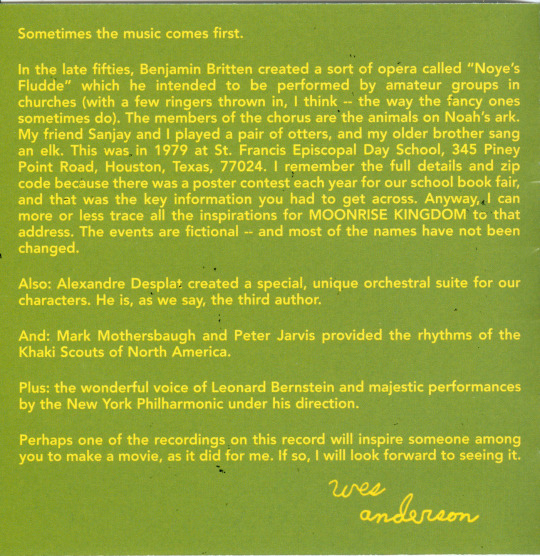
Liner notes to the “Moonrise Kingdom” soundtrack (ABKCO, 2012):
Sometimes the music comes first.
In the late fifties, Benjamin Britten created a sort of opera called
“Noye’s Fludde” which he intended to be performed by amateur groups in
churches (with a few ringers thrown in, I think - the way the fancy ones
sometimes do). The members of the chorus are the animals on Noah’s ark. My friend Sanjay and I played a pair of otters, and my older brother sang an
elk. This was in 1979 at St. Francis Episcopal Day School, 345 Piney Point
Road, Houston, Texas, 77024. I remember the full details and zip code
because there was a poster contest each year for our school book fair, and
that was the key information you had to get across. Anyway, I can more or
less trace all the inspirations for MOONRISE KINGDOM to that address. The
events are fictional – and most of the names have not been changed.
Also: Alexandre Desplat created a special, unique orchestral suite for our
characters. He is, as we say, the third author.
And: Mark Mothersbaugh and Peter Jarvis provided the rhythms of the Khaki
Scouts of North America.
Plus: the wonderful voice of Leonard Bernstein and majestic performances
by the New York Philharmonic under his direction.
Perhaps one of the recordings on this record will inspire someone among
you to make a movie, as it did for me. If so, I will look forward to
seeing it.
wes anderson
#benjamin britten#alexandre desplat#mark mothersbaugh#peter jarvis#leonard bernstein#moonrise kingdom#wes anderson#wesanderson#benjaminbritten#alexandredesplat#markmothersbaugh#peterjarvis#leonardbernstein#moonrisekingdom
0 notes
Photo

Liner notes to the “Fantastic Mr. Fox” soundtrack (ABKCO, 2009):
My first plan for Fantastic Mr. Fox was to commission an operetta and use its music as our score. I was excited about this idea. Our own operetta. Maybe it would even be performed independently of the film one day? Randall Poster and I started listening to Gilbert and Sullivan. In fact, we listened to every operetta we could get our hands on, repeatedly – and then we began to ask ourselves, “What was, supposedly, so great about operetta, in the first place, and why are we doing this?” Randall came up with a variation: old English dancehall standards, a genre the existence of which I had not been previously aware. This held our interest very briefly. Next came folk music from Scotland and Ireland, then bluegrass, then a vast catalogue of “jug band” records. We also spent several months researching the history of children’s music. I think the meandering might have been the result of the fact that it took us ten years to make the film. Eventually, our soundtrack included Davy Crockett, Burl Ives, The Beach Boys, The Rolling Stones, Georges Delerue, and Bobby Fuller (whom Marshall Crenshaw describes as “the most famous rock star ever to be murdered by gangsters”) – plus our friend Jarvis Cocker who wrote a wonderful song that became the animated centerpiece of the story. You probably needed to be there with us from the beginning to follow our train of thought.
But somehow Alexandre Desplat did just that. He wrote a score in his studio in Montparnasse (which I am told was formerly the sculptor Brancusi’s atelier) that seemed to combine every influence that we ever contemplated and then filtered them all through his own exceedingly refined and unique musical perspective. The result is something delicate and lyrical – yet grand. It is not particularly like anything else I can put my finger on. (He also taught me about tea, as he is something of an expert in this area, as well, and keeps various vintages on hand from Taiwan and Bhutan and Upper Cambodia).
He conducted with the puppets on the stand beside him at Abbey Road Studios in London – as you can see here.
– Wes Anderson 2009
#alexandre desplat#randall poster#davy crockett#burl ives#beach boys#rolling stones#georges delerue#bobby fuller#marshall crenshaw#jarvis cocker#fantastic mr. fox#alexandredesplat#randallposter#davycrockett#beachboys#rollingstones#georgesdelerue#bobbyfuller#marshallcrenshaw#jarviscocker#fantasticmrfox#wes anderson#wesanderson
0 notes
Photo

Liner notes to the “Darjeeling Limited” soundtrack (ABKCO, 2007):
I do not know much about Indian music, but I love the soundtracks to
Satyajit Ray’s and James Ivory’s movies. Ray wrote the scores for most of
his films himself, and he also scored one of Merchant-Ivory’s:
“Shakespeare Wallah.” His movies, especially the first one I saw (on
Beta), “Teen Kanya,” which is sometimes called “Three Daughters” and
sometimes only two, were part of what inspired me to try to make movies in
the first place. He tells personal stories that function – at least for
me – like novels, and draw you in more in the ways a great book does
than a movie. I especially enjoy his “Calcutta Trilogy” from the early to
mid-seventies, but I also love “Charulata” and the very beautiful “Days
and Nights in the Forest.” Ivory’s “Bombay Talkie” begins with possibly
the best title sequence of all time, and we use the musical cue from this
scene twice in our film. My favorite of Ivory’s movies, however, may be
the first one, “The Householder,” which has the gentleness and beauty of
Ray’s films – but it is in English, and it is set in Delhi as opposed to
West Bengal where most of Ray’s films take place. This distinction would
never have occurred to me and would not have had any meaning to me
whatsoever before I finally went to India two years ago, and I would never
have been inspired to visit and work in this place if I had not loved it
already through these filmmakers’ work (along with Louis Malle’s
documentaries and Jean Renoir’s “The River”).
I am very happy to have been allowed to use the music from these films,
which cast such a spell over me, and I hope it will do the same for you in
this new context.
– Wes Anderson
#satyajit ray#james ivory#merchant ivory#louis malle#jean renoir#darjeeling limited#wes anderson#wesanderson#satyajitray#jamesivory#merchantivory#louismalle#jeanrenoir#darjeelinglimited
0 notes
Photo

Introduction to “The Squid and the Whale: The Shooting Script” (Newmarket Press, 2005) by Noah Baumbach:

One night five years ago, my ex -girlfriend Jennifer and I had dinner with Noah Baumbach and his younger brother Nico at an Italian restaurant on the Upper East Side called Primola. I had already known Noah a couple of years. We saw each other frequently, always for dinner. There was a famous baseball player for the Mets, Rusty Staub, in the room that night. Noah said to Nico, “We should get his autograph for Dad.” Nico agreed, “We should.” Neither of the brothers gave any indication that he was going to actually try to accomplish this, but something had been triggered. They exchanged a few mysterious remarks and laughed. They drifted into a quiet discussion and then included us: they were talking about their father. They talked about joint custody, veal cutlets, Norman Mailer’s agent—the events of their childhood and of “The Squid and the Whale.” Noah told the stories, animated and energetic as he always is when he captures an audience and gets them laughing. Nico periodically interjected his own brief, deadpan details. We all listened through three courses. At the end of it, we were silent, as if a curtain had fallen. We ordered coffee, and I said, feeling smart, “That’s the movie you should make.” Noah said, “I’m working on it,” which it then occurred to me was pretty obvious. He is a writer and had clearly given the matter some thought. I said, “Well, I want to get in on this one,” and I did. I think the end result is his funniest, saddest, most honest film.
As we left the restaurant, Jennifer stopped at Rusty Staub’s table and sweetly collected his autograph for Mr. Baumbach. I had hoped to reproduce it below, but Noah has informed me that his father accidentally threw it out with the wrapping paper over Christmas.
—September 2005
0 notes
Photo

Liner notes to the “Life Aquatic with Steve Zissou” soundtrack (Hollywood Records, 2004):
One night in Rome, Noah Taylor gave me a C.D. he had burned and labeled with his baroque scribbling. (There was a ballpoint pen drawing of a shark attacking a swimmer on the cover.) It was the soundtrack album for the Australian husband and wife oceanographic filmmaking team Ron and Val Taylor’s (no relation) film “Innerspace” by Norwegian composer Swen Libaek. Noah told me to use in in the movie. Not only did I do that, but Randy Poster and I also got a hold of Libaek’s entire body of work (he is alive and well in Australia where he continues to write and produce music) and made him half (along with Mark Mothersbaugh’s Casio-esque “temp” pieces) the musical voice of Noah’s character Vladimir Wolodarsky, the Team Zissou physicist/original score composer. Libaek’s music is magical and dated in the most appealing ways.
Seu Jorge, as Pelé dos Santos, translated, adapted, and performed eleven David Bowie songs for us in Portuguese. He sang on the decks of our ship, the Belafonte, while we were running at full steam on the open sea; he sang from the stage of an opera house in Naples; he sang on our studio sets at Cinecitta; and he played one song sitting on the roof of a lighthouse we had built next to a medieval castle. I tried to understand the Portuguese. Thinking of the lyrics in English, I asked, “Jorge, which word means ‘cigarette’?” because none of them sounded anything like it. He nodded and said something very poetic about friendship and hope and the future – but no ‘cigarette’. I took a minute and thought about this, and then I said, “OK, but every once in a while add in a ‘Rebel Rebel’, will you?” I never read any complete translations, but in the end I am convinced that Jorge’s words – and unquestionably his beautiful performances – capture the spirit of David Bowie’s. Exactly what we were looking for.
– WES ANDERSON
#noah taylor#ron taylor#val taylor#sven libaek#mark mothersbaugh#seu jorge#randall poster#life aquatic#wes anderson#wesanderson#noahtaylor#rontaylor#valtaylor#svenlibaek#markmothersbaugh#seujorge#randallposter#lifeaquatic
1 note
·
View note
Photo
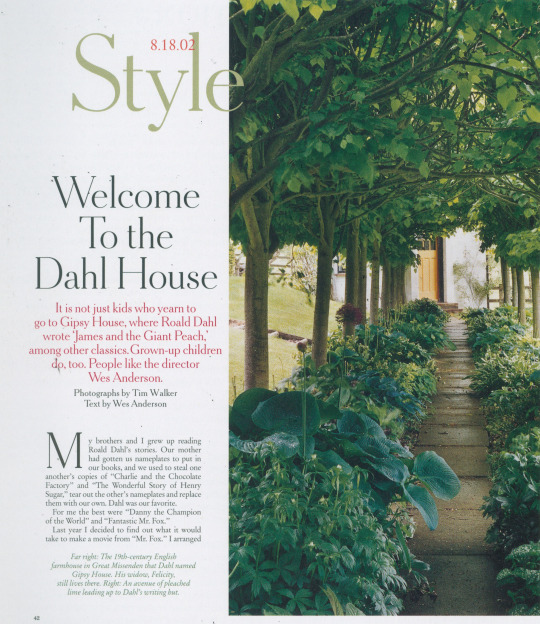
Travel essay published in the New York Times Magazine (August 18, 2002):
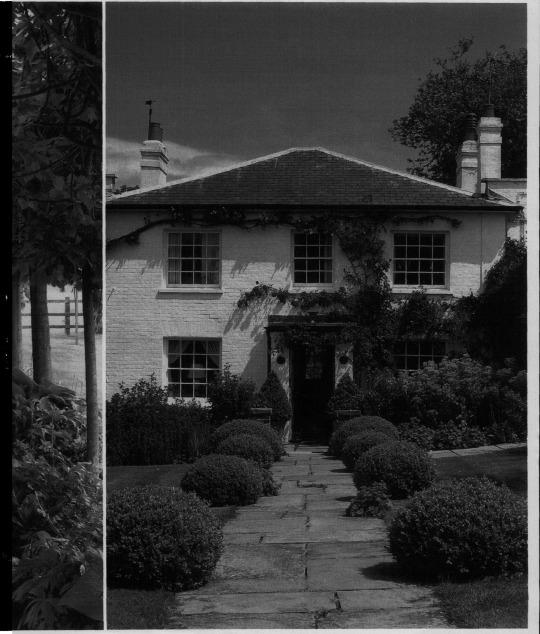
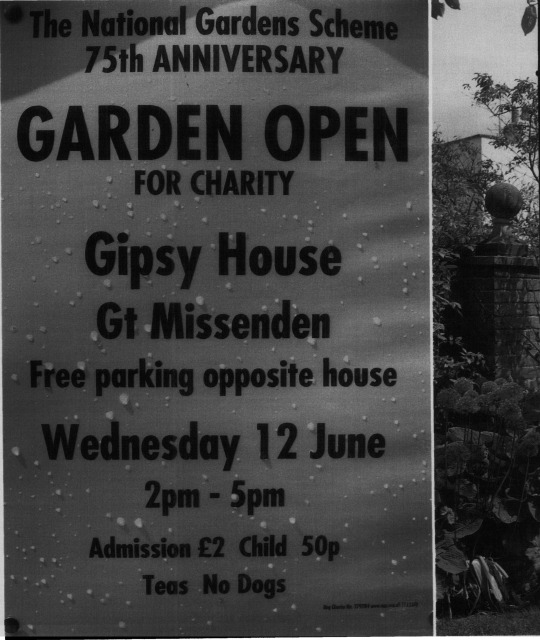
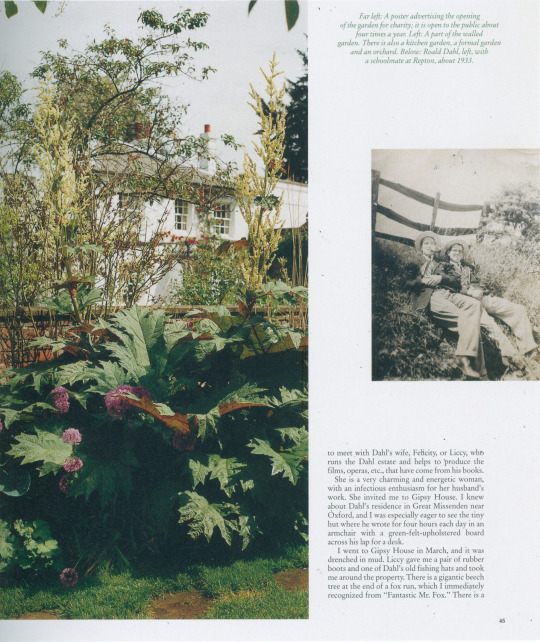




My brothers and I grew up reading Roald Dahl's stories. Our mother had gotten us nameplates to put in our books, and we used to steal one another's copies of "Charlie and the Chocolate Factory" and "The Wonderful Story of Henry Sugar," tear out the other's nameplates and replace them with our own. Dahl was our favorite.
For me the best were "Danny the Champion of the World" and "Fantastic Mr. Fox."
Last year I decided to find out what it would take to make a movie from "Mr. Fox." I arranged to meet with Dahl's wife, Felicity, or Liccy, who runs the Dahl estate and helps to produce the films, operas, etc., that have come from his books.
She is a very charming and energetic woman, with an infectious enthusiasm for her husband's work. She invited me to Gipsy House. I knew about Dahl's residence in Great Missenden near Oxford, and I was especially eager to see the tiny hut where he wrote for four hours each day in an armchair with a green-felt-upholstered board across his lap for a desk.
I went to Gipsy House in March, and it was drenched in mud. Liccy gave me a pair of rubber boots and one of Dahl's old fishing hats and took me around the property. There is a gigantic beech tree at the end of a fox run, which I immediately recognized from "Fantastic Mr. Fox." There is a painted gypsy caravan under a tree, which I had seen in dust-jacket photographs. There is a stone half buried on the edge of the drive with the word "gipsy" carved into it.
Liccy showed me into Dahl's famous writing hut. There is part of a bone from his hip on the table next to his first metal hip replacement, which didn't take. There is a 10-pound ball of aluminum foil made from several years of Cadbury chocolate wrappers. There is a little surgical valve he invented that saved his son from hydrocephalus.
That night Liccy left me to examine Dahl's manuscripts in an office next to the guest house. An archivist made me wash my hands twice with special soap and told me to close all the curtains and lock the door when I was finished. I was alone with dozens of handwritten drafts with Dahl's sketches in the margins, and I could see his whole process laid out in front of me. More than ever, I felt as if I were in his presence.
The next morning I walked with Liccy across a bridge over the highway to a church and the cemetery where Dahl is buried. The sky was dark, and it started to rain as we went to his grave. We shared an umbrella.
There is a monument made of a round wooden bench on a stone platform. Each of Dahl's eight children has a seat on the bench with his or her name carved into the back: Olivia, Tessa, Theo, Ophelia, Neisha, Charlotte, Lucy and Lorina. I wanted to sit for a while, but the bench was wet. Liccy and I walked back to the house in the rain. We had tea.
#roald dahl#fantastic mr. fox#felicity dahl#charlie and the chocolate factory#danny the champion of the world#the wonderful story of henry sugar#wes anderson#wesanderson#roalddahl
1 note
·
View note
Photo

Liner notes to the “Royal Tenenbaums” soundtrack (Hollywood Records, 2001):
This movie was my third experience with the composer Mark Mothersbaugh and I have come to look forward to this phase of the film-making process very much. Mark works in a large, round, fluorescent green building on Sunset Boulevard which strongly resembles a flying saucer, and he is surrounded by a highly complex staff. Dan Ping manages the finances, and always seems to be just returning from the desert (where she attends rituals of some kind) with a racially new hairstyle. Bob Casale, one of Mark’s Devo colleagues, engineers the recording sessions with the confidence of someone who has had beer bottles thrown at him onstage, and who has thrown them back. There is also Josh, who resembles a young Bob Dylan; Albert, who was married (and divorced) twice to the same girl by age 27; Van, Stacy, Michelle, plus Mark’s restauranteur friend Fred, his girlfriend/agent Anita, and brother Bob, who is usually seen sitting on the curb outside the studio smoking a cigar and reading the business section of the L.A. Times. The operation is known as Mutato Muzika, which I think is Esperanto, and it provides a very stimulating creative atmosphere. Our music supervisor Randy Poster describes Mark’s music as, “charmed, magical and sort of innocent,” and I think that also describes the feeling you get when you work with Mark at his studio. I hope you enjoy the record.
– wes anderson.
#mark mothersbaugh#randall poster#dan ping#bob casale#bob mothersbaugh#royal tenenbaums#markmothersbaugh#randallposter#danping#bobcasale#bobmothersbaugh#royatenenbaums
1 note
·
View note
Photo

Liner notes to “Rushmore” soundtrack (Polygram, 1999):
I originally wanted to score the whole movie of ‘Rushmore’ with songs by the Kinks. I thought this made sense because the Kinks played loud, angry, teenage rock songs, and they wore blazers and ties; and our movie is about a teenager who is loud and angry, and he is almost never seen without his blazer and tie (until he switches to a green velvet suit). I eventually expanded this concept to include the whole British Invasion, because they all basically dressed like that.
Then we did some research and started making tapes labeled SCHOOL MOVIE MUSIC, which I listened to on road trips while were writing the script. Sometimes I put the same song on a tape five or six times in a row, because your mind wanders when you’re on the road, and repetition helps you focus your concentration. We played lots of this music on the set during the shoot in Houston with a Bose stereo that Bill Murray got for us. My assistant had to lug the Bose around and got electricians to give her extension cables, and the inconvenience of that eventually led her to quit, although there were probably other factors which I don’t know about. At the end of the shoot Murray gave the Bose to one of the make-up people. The only song we used that’s not British Invasion (except Zoot Sims and Mark Mothersbaugh) is the Yves Montand rendition of ‘Rue Saint Vincent,’ but I think that’s a good one to stand on its own.
Thanks very much and I hope you enjoy this album.
– wes anderson.
#the kinks#bill murray#zoot sims#mark mothersbaugh#yves montand#rushmore#the+kinks#billmurray#zootsims#markmothersbaugh#yvesmontand#wes anderson#wesanderson
0 notes